When you buy through our links, we may earn an affiliate commission.
Patch cables—they're one of the most important parts of a larger audio rig, be it for guitar or running rack gear, and are shrouded in a surprisingly deep level of mystery.
If you spend much time in the more obsessive audio enthusiast circles, you'll likely have been wrapped up in some debate about the advantages of gold-plated connectors or wire coating types.
Beyond this, just knowing which type of patch cable you need can be a bit of a headache with so many technical terms flying around, covered in a mist of marketing talk.
Well, there are several important distinctions to understand when it comes to patch cables, as it's not a case of one-size-fits-all.
In this guide, I'll share some of the best patch cables for a range of different uses, including guitar pedals, studio racks, patch bays, and more.
I'll also explain some important concepts to understand, which will help you to find the right, and best patch cable for your needs!
As a starting point, for pedalboard patching, I recommend the Ernie Ball P06225 Flat Ribbon Pedalboard Patch Cable - you can't go wrong with these!
Let's get plugged in!
Patch Cable Types!
There are a few different types of patch cables, each with slightly specific uses, although often they can be used for a range of purposes.
These types are each designed for certain use situations, typically depending on the type of gear they are used with.
The most common types of patch cables include:
- Guitar patch cables (1/4 mono TS)
- TRS 1/4 - For 19" rack units
- Bantam - smaller patch cables for bantam patch bays
- XLR - For patching XLR gear and microphones
Quick Summary of the Best Patch Cables
- D'Addario PW-CGTPRA-01 Classic Series Pedalboard Patch Cable - Right Angle - 1 foot (Budget Pedalboard Connector)
- D'Addario PW-CGTP-105 Classic Series Pedalboard Patch Cable - Right Angle - 6 inch (Slightly Longer than Above)
- Hosa CPP-103 Interconnect Cable - 1/4-inch TS Male- 3 foot (For Patch Bays)
- Hosa IRG-100.5 Low-profile Right Angle Guitar Patch Cable - 6 inch (Slim Pedal Connectors)
- Ernie Ball P06225 Single Flat Ribbon Pedalboard Cable - Right Angle - 3 inch (Best for Tight Pedalboards)
- D'Addario PW-CGTP-01 Classic Series Pedalboard Patch Cable - Straight - 1 foot (For Certain Pedals)
- EBS PCF-DL18 Deluxe Flat Patch Cable - Right Angle - 7.09 inch (Deluxe, Mid Length)
- MXR 3PDCP06 Right Angle Pedalboard Patch Cable - 6-inch (3-pack) (High-Quality Multi-Pack)
- EBS PG-58 Premium Gold Flat Patch Cable - Right Angle to Right Angle - 22.83 inch (Premium Long Cable)
- D'Addario PW-CGTP-305 Classic Series Pedalboard Patch Cable - Right Angle to Right Angle - 6 inch (3-pack) (Affordable Multi-Pack)
- EBS HP-10 High Performance Flat Patch Cable - Right Angle to Right Angle - 3.94 inch (3-Pack) (Premium Multi-Pack)
- Ernie Ball P06224 Flat Ribbon Pedalboard Patch Cable - Right Angle to Right Angle - Multi Pack Black (Pro Bundle)
- Emerson Custom G&H Solderless Patch Cable Kit - 12 foot - Purple (Custom Kit)
Best Patch Cables
Here are the best patch cables on the market today.
1. Budget Pedalboard Connector – D'Addario PW-CGTPRA-01 Classic Series Pedalboard Patch Cable - Right Angle - 1 foot
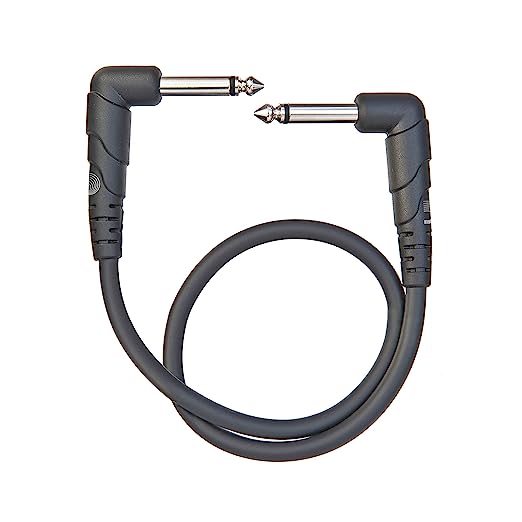
SPECS
- Connection: TS male 1/4"
- Head Type: 2 x Right-angle
- Profile: Round
- Length: 1 foot
D'Addario is a familiar name in the guitar gear world and makes high-quality products from guitar strings to cables.
These high-quality patch cables are an ideal choice for guitarists looking for a guitar cable to connect their guitar pedals together, thanks to the right-angled headers.
The internal wiring uses oxygen-free copper, which is long-lasting and doesn't degrade the sound quality.
These particular cables are 1 foot in length, which might be slightly too long for some situations, so check out the shorter variations too!
2. Slightly Longer than Above – D'Addario PW-CGTP-105 Classic Series Pedalboard Patch Cable - Right Angle - 6 inch
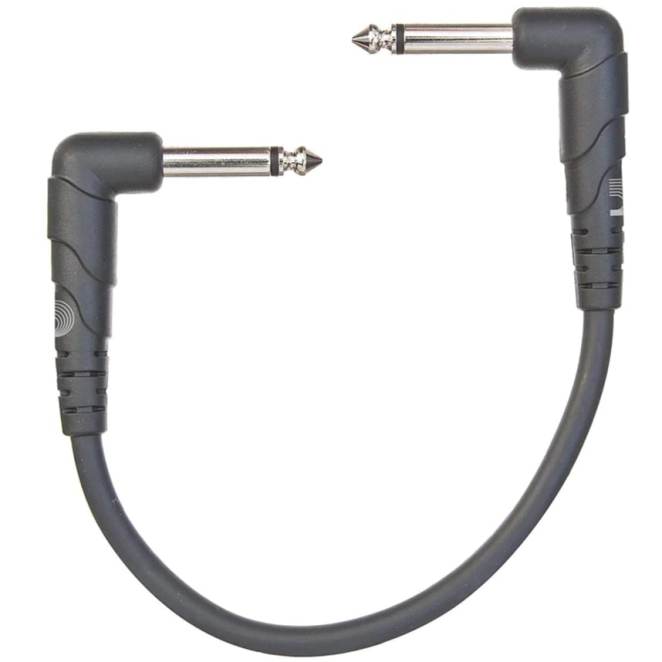
SPECS
- Connection: TS male 1/4"
- Head Type: 2 x Right-angle
- Profile: Round
- Length: 6 inch
These quality cables are essentially identical to the model above, just using a shorter 6-inch length.
This shorter length makes them even more suitable to be used as guitar pedal connectors, although you will have to spend an extra dollar per cable.
3. For Patch Bays – Hosa CPP-103 Interconnect Cable - 1/4-inch TS Male- 3 foot
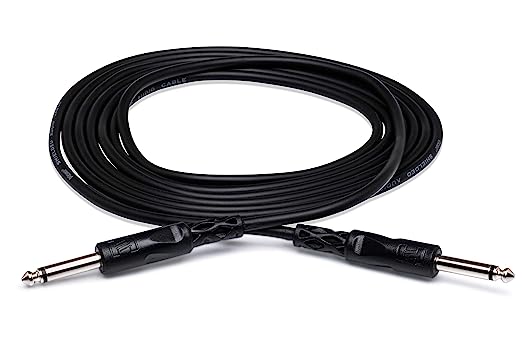
SPECS
- Connection: TS male 1/4"
- Head Type: 2 x Straight
- Profile: Round
- Length: 3 foot
The Hosa Interconnect cables use a long and straight-headed design. This type of cable is more suited to use in a patch bay or for connecting rack and other studio gear together.
These instrument cables are three feet long and use a straight connector. This means they aren't particularly useful for guitar pedal boards but are better than short, right-angle cables in many other situations.
4. Slim Pedal Connectors – Hosa IRG-100.5 Low-profile Right Angle Guitar Patch Cable - 6 inch
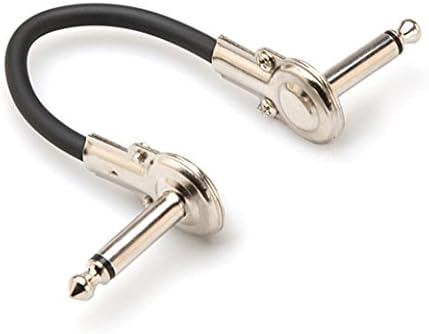
SPECS
- Connection: TS male 1/4"
- Head Type: 2 x Right angle
- Profile: Flat
- Length: 6 inch
If you're looking for a streamlined and affordable patch cable to use on your guitar pedal board, this model from Hosa might just be the best choice.
These flat ribbon patch cables are incredibly slim, meaning you can pretty much have your pedals sit right next to each other without needing much space in between. They use a flat profile with a right-angle header, giving them the best design for saving space on your pedalboard.
5. Best for Tight Pedalboards – Ernie Ball P06225 Single Flat Ribbon Pedalboard Cable - Right Angle - 3 inch

SPECS
- Connection: TS male 1/4"
- Head Type: 2 x Right angle
- Profile: Flat
- Length: 3 inch
Ernie Ball is another huge name in the guitar gear scene, and these cables live up to their high-quality reputation.
These Ernie Ball flat patch cables are also one of the best choices for a tight pedal board. Thanks to their flat profile, right-angle headers, and short 3-inch length, you can pack in a bunch of pedals on your board with no wasted space.
Being 3 inches, these Ernie Ball patch cables might be too short for some connections, but if you're a pedal user, then you can't go wrong by having a couple of these in your kit.
6. For Certain Pedals – D'Addario PW-CGTP-01 Classic Series Pedalboard Patch Cable - Straight - 1 foot
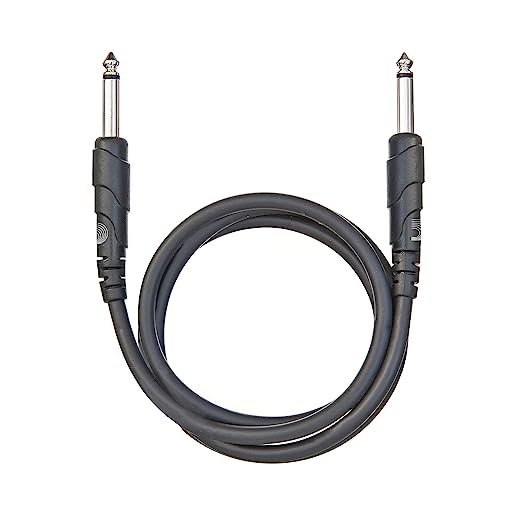
SPECS
- Connection: TS male 1/4"
- Head Type: 2 x Straight
- Profile: Round
- Length: 1 foot
A slight variation from the models mentioned earlier, these 1-foot guitar cables use a straight-straight header design. This might make them unsuitable for certain pedalboard situations, although these are a great deal when you need this type of cable for connecting gear.
7. Deluxe, Mid Length – EBS PCF-DL18 Deluxe Flat Patch Cable - Right Angle - 7.09 inch

SPECS
- Connection: TS male 1/4"
- Head Type: 2 x Right angle
- Profile: Flat
- Length: 7.09 inch
The EBS Deluxe flat patch cable is another great choice for pedalboard uses. Unlike cheap cables, these are gold-plated patch cables, meaning they should keep your signal chain crisp and clean.
While they are a little pricier than others, these are some of the best-quality patch cables on the market today.
Paired with the right-angle, flat profile headers is a flat cable. This combo gives your pedalboard a super streamlined and tidy look.
8. High-Quality Multi-Pack – MXR 3PDCP06 Right Angle Pedalboard Patch Cable - 6-inch (3-pack)
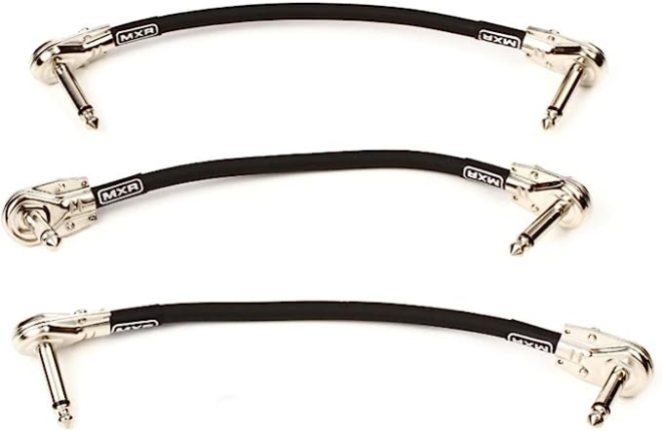
SPECS
- Connection: TS male 1/4"
- Head Type: 2 x Right angle
- Profile: Flat
- Length: 6 inch
If you're looking to save a bit of cash but still want some exceptional patch cables, then this 3-pack of deluxe cables is a strong choice.
These have the perfect design to be used as pedal couplers thanks to their short length, right-angled header, and flat profile. These are some of the slimmest cables available.
Buying in a three-pack gives you a reduced price overall, meaning you can save money while filling your kit with some top-end cables!
9. Premium Long Cable – EBS PG-58 Premium Gold Flat Patch Cable - Right Angle to Right Angle - 22.83 inch

SPECS
- Connection: TS male 1/4"
- Head Type: 2 x Right angle
- Profile: Flat
- Length: 22.83 inch
Coming in just short of two feet, these gold-plated premium patch cables offer exceptionally high quality - albeit at a higher price.
If you need a longer cable with flat, right-angle connectors, then these are some of the finest on the market. They are too long to use for connecting neighboring pedals, but if you are running some kind of longer rig setup, these are sure to give you a strong connection.
10. Affordable Multi-Pack – D'Addario PW-CGTP-305 Classic Series Pedalboard Patch Cable - Right Angle to Right Angle - 6 inch (3-pack)
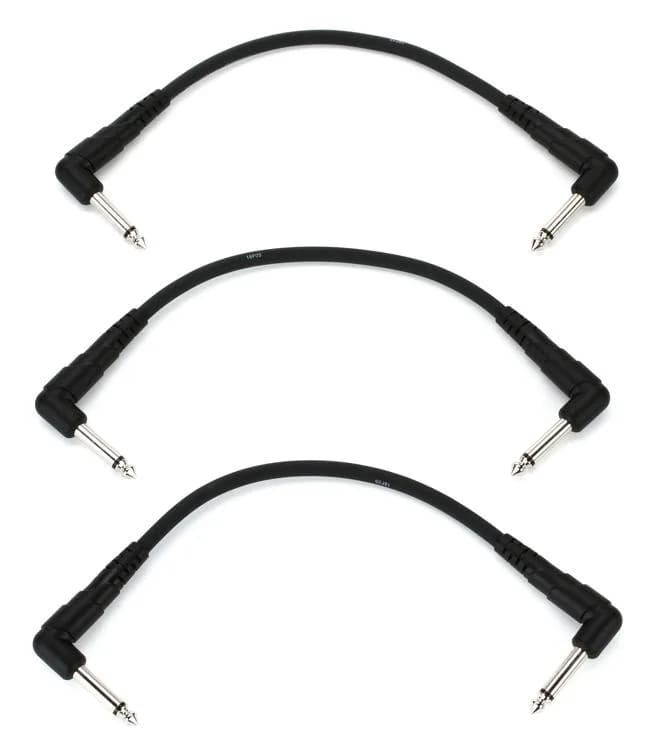
SPECS
- Connection: TS male 1/4"
- Head Type: 2 x Right-angle
- Profile: Round
- Length: 6 inch
This three-pack bundles some of D'Addario's classic pedalboard patch cables together, so you can connect up to four guitar pedals together. These are identical to the models shown above, just coming in a three-pack. The design of these is ideal for use on a pedal board.
11. Premium Multi-Pack – EBS HP-10 High Performance Flat Patch Cable - Right Angle to Right Angle - 3.94 inch (3-Pack)
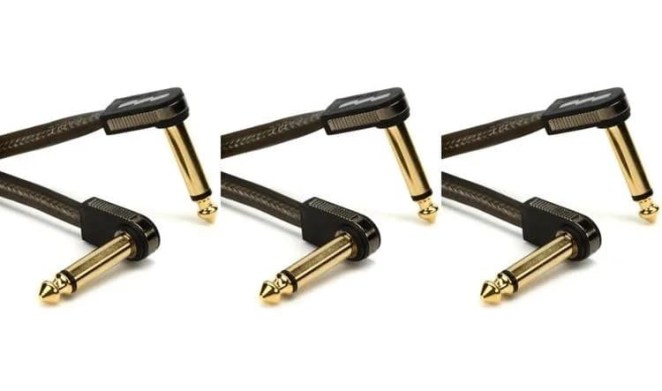
SPECS
- Connection: TS male 1/4"
- Head Type: 2 x Right angle
- Profile: Flat
- Length: 3.94 inch
These EBS HP-10 pedalboard connectors have also been shown above, although this link is for a shorter length, just shy of 4 inches. This 3-pack gives you some of the highest quality cables in a tidy bundle.
With a right-angled, flat profile connector, these gold-plated cables are the connector of choice for discerning pedalboard users.
12. Pro Bundle – Ernie Ball P06224 Flat Ribbon Pedalboard Patch Cable - Right Angle to Right Angle - Multi Pack Black

SPECS
- Connection: TS male 1/4"
- Head Type: 2 x Right angle
- Profile: Flat
- Length: 3 to 24 inch
If you're running a complex guitar pedal rig, this cable bundle is a lifesaver. This pack gives you 10 cables in a single purchase, with lengths ranging from 3 to 24 inches.
With this collection, you're sorted when it comes to setting up your guitar pedal rig. It has shorter cables for making close connections but also comes with some longer cables if you need to have some pedals a bit further apart.
The price tag offers you a reduced cost compared to buying all the cables individually, meaning this pack offers excellent value for money.
13. Custom Kit – Emerson Custom G&H Solderless Patch Cable Kit - 12 foot - Purple

SPECS
- Connection: TS male 1/4"
- Head Type: Straight
- Profile: Custom
- Length: Custom
If you're looking for something that offers more flexibility and customization, this type of patch cable kit is the perfect choice. It comes with 12 feet of cabling, and 12 connectors, so you can make 6 custom patch cables.
This is a solderless kit, meaning that you don't need any experience with a soldering iron to make your custom cables. The quality of the materials is decent, too, using internal spiral shielding to protect from interference and oxygen-free copper conductors to ensure a long lifespan.
This is by far the most cost-efficient way to create custom patch cable setups - other than soldering your own from scratch!
Best Patch Cables Buyer's Guide
With so many patch cables to choose from, you might get your head in a tangle trying to pick the right type.
Don't worry! This guide will keep your melon un-twisted by giving you all the points you need to think about to choose the best patch cables for your needs!
Angled or Straight?
One of the first considerations to make is the type of angle on the header. The connector ends usually either come as straight cables or with an angle (typically a right angle).
The type you want to pick ultimately depends on the use case. Right-angle cables are the best option (usually) if you plan on using them with a bunch of pedals on a pedal board.
The right angle means you can lay your pedals closer together on the board, saving space. Otherwise, with straight cables, it would be awkward to place them next to each other.
However, if you plan on using the patch cables with a patch bay, synth, or basically any other situation, for example, on a patch bay, you really can only use straight cables; otherwise, it's difficult to pull them out. Other than being used for guitar pedals, straight cables are usually more convenient.
Profile - Flat or Fat?
A further consideration when it comes to the design of patch cables is whether you go for flat or fat profiles.
Typically, most cables come in a standard fat shape. It isn't really fat but is fat compared to the flat profiles. Flat profiles can be really handy when you're tight on space, for example, on a guitar pedal board.
Although, they can be a nuisance if you are trying to grab the cables a lot, like in a patch bay or modular synth.
Again, the choice here depends on your use case. If you need your patch cables for a pedal board, I would suggest going for the flat variety to save space (depending on the types of peals you are using). Otherwise, go for the regular rounded/fat type.
Length
Patch cable length is another important factor, which, again, comes down to the situation you are going to be patching in. Unlike cables for guitars which will vary in length, the main tip here is to go for patch cables that are as short as possible for the use case.
If you are using them on a pedal board, then most of the time, you can use patch cables between 3 and 6 inches.
If you're using them in a patch bay, then you'll need something between 12" and 1m. This gives you enough room to patch between the backs of a larger 19" rack too.
Longer cables are more expensive and take up more room. So, you don't want to waste money and space by having unnecessary lengths of cable hanging around unused.
That said, longer cable lengths give you more freedom overall, so you'll have to weigh up the length/cost/benefit balance for your situation.
Connection Type - TS, TRS, XLR, Bantam, or Any Combination
Another absolutely essential consideration is the connection type. The term 'patch cable' can refer to a huge range of cables, and even many beyond the scope of music (like ethernet cables).
Obviously, we're talking about musical patch cables here, but even so, there is a huge range of connection types.
The key is to make sure you are buying patch cables with the right kind of connection for whatever gear you are patching up.
Usually, it's pretty obvious, but here are some explanations for each type.
TS - Tip/Sleeve - These are used for transmitting a mono signal and are most common in the 1/4" format. These are the type you need for guitar pedals and are compatible with most types of rack gear and mono mixing desk channels.
TRS - Tip/Ring/Sleeve - These can carry two independent channels of signal, so they can work for stereo inputs and outputs, which are found on many 19" rack units and mixing desks, and a lower number of guitar pedals.
They can also be used for transmitting balanced audio signals, which is too complex to explain here but worth researching if you want a deeper level of knowledge.
These are good when you need them (for single cable stereo or balanced signals), but otherwise, they add an unnecessary cost and can cause issues.
XLR - These are a 3-pronged type of cable which are also commonly known as a mic connector. These are used on many 19" rack units, mixing desks, audio interfaces, speakers, and XLR patch bays. To get the right option for you, check out our best XLR cables reviews.
Typically, these are more of a special/professional connection, so you'll know if this is the type you need.
Bantam - These are unique types of miniature patch cable connectors. These are only designed to work to connect various ports on the front side of a bantam patch bay, and you won't find any of these connections on pedals, rack units, or other gear.
Bantam patch bays give you more patching options by using the smaller patch inputs to save space on the patch bay's face. Again, you'll probably know if this is the type you need, so avoid them if you are unsure.
Aesthetics - Color Coded?
While this factor isn't as important as the others, it's still something worth considering, particularly for larger studios.
It can be super helpful to have color-coded patch cables - especially if you are running complicated patch bays, modular synths, or even some complex pedal boards. You can buy packs of color-coded patch cables, which can make it super easy to see how the signal flow is being directed.
It isn't essential, but if you are running a larger or more complicated setup, a bit of color coding goes a long way.
Frequently Asked Questions (FAQs)
What patch cables should I use?
The type of patch cable you should use ultimately depends on the situation you are using them. For guitar pedals, the best patch cables are typically shorter in length, use a TS 1/4" connector, and have a right-angle end.
For patch bays, you'll want to use a straight connector and typically a 1/4" TRS or even bantam connection.
Are shorter patch cables better?
Shorter patch cables can be better if you need to save space or money. However, for flexibility, longer cables are more freeing. Shorter cables are ideal for connecting guitar pedals.
Also, you don't want to have excess wasted cable length, as this adds resistance and impedance to the guitar tone, which can dull the signal if extra lengths are used.
Are all guitar patch cables the same?
Most guitar patch cables are basically the same. They'll typically all use the same connection type (a 1/4" TS jack), although there can be several variations in other elements of the cable.
The main variations are the end shape - either straight or angled, the profile - either flat or round, and the length, which typically comes anywhere from 3" to 12".
You'll also see some discussion about the materials used in the cables. For instance, people often argue that certain inner cable materials sound better than others. Or the classic argument surrounding the advantages of using gold-plated jack connectors.
This is a huge and widely contested debate, and typically gold connectors are sold at a massively higher price, although they only have a questionable advantage. So do your own research into the material debate if you have a larger interest in this.
Conclusion
Now you have a good idea of the types of patch cables available and what things you need to consider to pick the right type.
Ultimately, the best patch cable depends on the type of gear and situation you are going to be using it for.
For guitar pedals, I think the Ernie Ball P06225 Flat Ribbon are some of the best patch cables out there and give you exactly what you need to get a tightly patched pedalboard!
